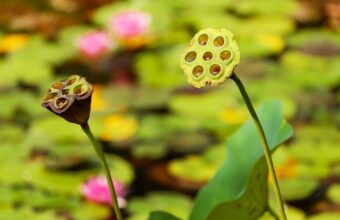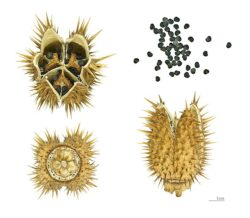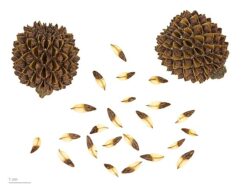In this article, we will discuss why and grow you should save your seed.
Most people have lost the ability to save seeds, as this is one of the best ways to save money, the question is why should you buy seeds when you can save your own?
The problem is that in the last 50 years or so gardeners have gradually turned from seed gathers and savers to buying commercial seeds.
THE SEEDS YOU BUY TEND TO BE CROSSES
This is because most seeds you buy are crosses of two or more parent plants, and therefore will not breed true if seeds are sown and planted. I believe it is time, we start saving and planting our own. The seeds you are looking for are called open-pollinated varieties.

When you harvest open-pollinated seeds from your own garden, you are saving your own strain of that vegetables, tree, or flowers. The strain will be a living gene bank that has adapted to your own growing conditions. Every seed you save will be slightly different and will have a better chance of surviving and therefore growing.
For example, if you grow seed from an open-pollinated, heirloom variety you bought online and you save the seed, the seed you saved will slowly adapt to your growing conditions at home. You will then get greater success.
COMMERCIAL SEED TEND TO BE IDENTICAL
Commercial hybrids that you buy every year have been developed to be identical in every packet every year. This indicates that the garden will have to adapt to the growing conditions that the seeds are exposed to rather than the other way around.
This means to succeed we have to create a standardised growing system using standard growing conditions and nutrient requirements. The problem with this is that the growing conditions are never stable, as our climate constantly changes from season to season. The seeds you harvest will slowly adapt to our specific growing conditions and so adapt to our future growing needs.
COLLECTING SEEDS IS EASY
Collecting seeds is easy, provided you have a collecting bag a label and a willingness to give a part of your fridge to the harvest.
Seeds are formed when a female flower is successfully pollinated and fertilized by pollen transported by either wind, insects or other means. Once fertilization takes place an embryo starts to form in the seed. The new life contains the DNA material that will form the roots, stems, leaves and then the flowers of a new plant.

The embryo is covered in a hard coating known as the seed coat, which not only protects it from getting injured but also prevents it from germinating if the growing conditions are not right. On top of the coat, some seeds are protected by a fleshy residue known as fruit pulp.
These fruits are usually there to get an animal to take the fruit and therefore the seeds within them to a different place. This will increase the chance of the seed germinating and growing in a new land. Others seeds are encapsulated in a container that delays seed dispersal until the seed is ready to pop out as it ripens.
A seed head does not open its aperture until the seeds are mature enough state to be dispersed. This is why you have to catch the seed at the right time, neither too immature nor too dried up. A good indicator of this is that the seed often darkens and the hard coat starts to form (not soft outside).
START SEED SAVING IN AUTUMN
Most plants will set seed at the end of the growing season, usually in autumn. The problem is that autumn is not an ideal time to harvest seeds, as it is getting cold, the rain will be lashing down, and frosts are likely to be forecasted.
This is not a wise time to germinate and hence why the seed coat must be formed at this time. The harder the seed coat more likely the seed is prevented from germinating at the wrong time, and the seed will last longer.
This hard seed coat is often impervious to water and needs a good soak before germination will occur, This is why in spring a good soak is required to get the seed to spring into action.
HOW TO COLLECT AND STORE SEEDS
Most seeds, apart from Primula veris, need the seeds to be sown ripe for good germination. To this most seed need to dry out to prevent the seeds from rotting, going mouldy and quickly becoming unviable.

If at seed collecting time, nature will have dried your seeds for you but you will have to time when to collect them. If you are too late the seed head will split open and the seeds will fall to the ground or the wind will take it away. In many instances, it is better to take the whole seed head off and dry the seed inside so that the harvest is not missed. This is very important if it is wet, otherwise, they will rot before they mature. Hang these seed heads upside down over a bucket and as they slowly open they will be captured in the bucket.
You can also place a paper bag underneath add this will allow your seed to continue to dry. If you want to collect seeds whilst you are walking, just take a little paper bag and this will allow you to collect seeds on the go.
HOW TO CLEAN SEEDS
Seeds, in general, will need to be cleaned before you store them. Nature has developed different fruiting bodies to protect the seeds and aid the dispersion of ripe ones. Some seeds are easy to harvest other than cleaning off the chaff, whilst others take a lot of effort.
All clean and dried seeds should be stored in small and sealed packets, small canisters, small Tupperware or plastic tubs, can be used. All paper packets or envelopes should be stored in a plastic box or tin box with a lid, as airtight conditions are very important.
Ideally, the box will be stored in a fridge at a temperature of 1 to 5 degree Celsius. If you do not have any space in your fridge, you must store it in a cool and dry place. Warm, humid conditions will kill seeds very quickly.
HOW TO RECOUP WET SEEDS
To clean seed from fleshy fruit pulp, such as melons, pumpkins or other squashes, scoop as many seeds from the fruit as possible. Use the back of a spoon and rub the seeds into a sieve under running water until the flesh comes off. Once this has been done and little of the flesh remains, spread the seed out on kitchen paper and let them dry before storing them.
To get the seed from berries, simply put them in a fine sieve and squash them under running water until they are well mashed. Place the fruit pulp into a jar full of water and allow it to settle. The viable seeds will sink to the bottom, whilst the fleshy, unviable ones float. Carefully pour out the liquid so that the seeds stay in the jar, the rest can be disposed of. After this, place the wet seeds on kitchen paper and allow them to dry out.
SOME SEEDS ARE PROTECTED
Tomato seeds are surrounded by fleshy gloop that will inhibit the seeds from germinating, which will need to be removed. The easy way to clean the seed is to ferment them, but this causes a stinky mess and takes several days.

The alternative is to cut the tomato in half and scoop out the seeds and pulp. Wash as much pulp off as possible whilst running water under a fine sieve.
Place the seeds and pulp in a glass to which 250ml of water has been added. To this, add a squirt of washing up liquid with a few crystals of soda crystals have been added. Leave this overnight where the viable tomato seeds will sink to the bottom of the glass.
Immature seeds will float and should be disposed of by scooping them out with the foam. The good seeds need to be strained through a fine sieve and leave the seeds to dry on a china plate or better a coffee filter paper. Store the dry tomato seeds in an airtight container in the fridge or a cool place.
SEEDS THAT LIKE IT TO BE DAMP
Not all seeds like it to be dry and some seeds like acorns, walnuts and Magnolias need to be stored wet. If they dry out, they lose their ability to take up water again and they will not germinate. It is best to store these in vermiculite and in a sealed bag in a fridge.
COLLECTING DRY SEEDS
When you collect dry seeds from their capsule, so it on a dry day. Some seeds are easy, like columbines, love in the mist, poppies, snapdragons and foxgloves. All you do is tip the plant, shake the capsules onto a piece of paper, separate the chaff and seeds, and then store them in a paper envelope.
Smaller, finer seeds that are hard to extract can be rubbed through a fine sieve over a piece of paper. This is useful for those dainty flowers as they can be cleaned this way.
WHAT HAPPENS IF YOU DECIDE TO SAVE CROSS-POLLINATED SEEDS?
If you have a garden that has a lot of different varieties of the same genus of plants close together, they will cross-pollinate. If you decide to collect the seeds, some will have hybridised.
This is because the pollen from one male flower is taken to the stigma of a female flower of another plant of the same species, as the pollinators do not care about the purity of the breed. Their mission is simple, survival. Left alone, you will get multiple varieties of different plants. If you want to keep the seeds above you have to protect them from pollinators that can mix the breed up.
This is hard work and some say impossible as you will need to guard the plant against other pollinators. You will need to pollinate the plants by hand and then protect each one by placing a bag over them
There is no reason not to collect hybrid seeds and this has been going on for years, where interesting hybrids have been made. Just remember if you want exactly the same plant again, you will need to isolate the flowers from other pollinators.
CONCLUSIONS
In this article, we have talked about why you would want to save your own seeds, how to do this and the best way to collect them.
This is worthwhile to do as long as you are prepared to do it, have the patience to do so and are prepared to isolate wanted hybrids.
Do not be chained to the seed companies and start harvesting your own today.
If you have any questions that you wish to ask on harvesting and storing seeds, please do so in the comment box below.
Happy seed saving.
